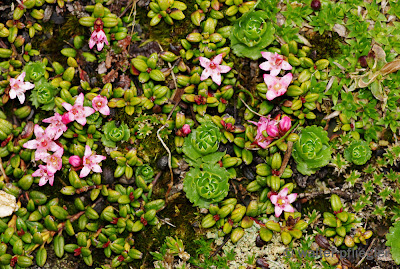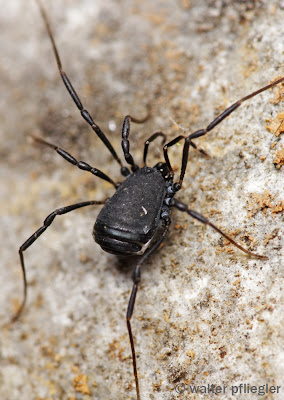
We spent 3 days in the higher parts of the Großglocknerstraße in the Hohe Tauern mountains. Our base was at 2300 meters above sea level, over the tree line in the true alpine zone. The plants and animals here are real specialised ones, they are able to survive the hard winters and the rapid changes in temperature during the short summer. We encountered many species that we've never seen before and I made so many photos that I have split this trip report into two parts: in the first, I only show plants and lichens.
Wir haben 3 Tage in den höheren Regionen der Großglocknerstraße in den Hohen Tauern verbracht. Unsere Basis war auf einer Höhe von 2300 m, über der Baumgrenze in der echten alpinen Zone. Die Pflanzen- und Tierarten hier sind wahre Spezialisten, die fähig sind, den harten Winter und die rasch wechselnde Temperaturen während des Sommers überzuleben. Wir haben viele solche Arten gefunden, die wir zuvor noch nie gesehen hatten, und ich habe so viele Fotos gemacht, dass ich den Bericht aufgeteilt habe: in dem ersten Post zeige ich nur Pflanzen und Flechten.
Három napot töltöttünk a Großglocknerstraße magasabb részén a Hohe Tauern hegyei közt. A bázisunk 2300 méteres magasságban volt, a fahatár felett az igazi alpin zónában. Az itt élő növények és állatok igazi specialisták, képesek túlélni a kemény teleket és a gyors hőmérséklet-változásokat a rövid nyár során. Sok olyan fajt láttunk, melyeket korábban soha sem, és olyan sok fotót készítettem, hogy a beszámolót kettévágtam: az első részben csak a növények és zuzmók szerepelnek.
Location/ Ort/ Helyszín: Großglocknerstraße, Austria./ Großglocknerstraße, Österreich./ Großglocknerstraße, Ausztria. Date/ Datum/ Dátum: 12-14.06.2012.
Bigger map
Looking at the peak Sinweleck (3261 m):
Blick auf den Gipfel Sinweleck (3261 m):
Kilátás a Sinweleck nevű csúcsra (3261 m):


The alpine zone:
Die alpine Stufe:
Az alpin szint:



Soil is very scarce in the higher territories of the alpine zone:
Erde ist sehr knapp in den höheren Bereichen der alpinen Zone:
Talaj alig akad az alpin zóna magasabb részein:

Most plants form cushions or mats to survive here. Other herbaceous ones are simply very small and there are also dwarf shrubs. For many species, it may take years to develope a single blossom!
Meiste Pflanzen formen Pfolstern oder Teppiche um hier überleben zu können. Andere krautige Pflanzen sind einfach sehr klein und es gibt auch Zwergsträucher. Für viele Arten dauert es Jahren, um eine einzige Blume zu entwickeln!
A legtöbb növény errefelé párnákat vagy szőnyegeket képez, hogy életben maradhasson. Más lágyszárúak egyszerűen csak nagyon aprók, ill. vannak törpecserjék is. Sok fajnak évekbe telik, mire egyetlen virágot meghoznak!

The Least Primrose (Primula minima) lives between 1700 and 3000 meters above sea level:
Die Zwerg-Primel (Primula minima) lebt zwischen 1700 und 3000 m in den Gebirgen:
Az apró kankalin (Primula minima) 1700-3000 méteres magasságokban nő:



The Purple Mountain Saxifrage (Saxifraga oppositifolia):
Der Gegenblättrige Steinbrech (Saxifraga oppositifolia):
A fedelékes kőtörőfű (Saxifraga oppositifolia):

Another saxifrage:
Ein anderer Steinbrech:
Egy másik kőtörőfű:

Not all plants grow cushions, like this forget-me-not species (Myosotis sp):
Nicht alle Pflanzen formen Pfolstern, wie diese Vergissmeinnicht-Art (Myosotis sp):
Nem minden növény alkot párnát, mint pl. ez a nefelejcsfaj sem (Myosotis sp):

The Lesser Alpine Pasqueflower (Pulsatilla alpina ssp. alba):
Die Kleine Alpen-Kuhschelle (Pulsatilla alpina ssp. alba):
A havasi kökörcsin (Pulsatilla alpina ssp. alba):


The Alpine Buttercup (Ranunculus alpestris):
Der Alpen-Hahnenfuß (Ranunculus alpestris):
A havasi boglárka (Ranunculus alpestris):

The Thore-Buttercup (Ranunculus thora):
Der Schildblättrige Hahnenfuß (Ranunculus thora):
A mérgező boglárka (Ranunculus thora):

The Globe-flower (Trollius europaeus):
Die Trollblume (Trollius europaeus):
Az európai zergeboglár (Trollius europaeus):

The Spring Gentian (Gentiana verna):
Der Frühlings-Enzian (Gentiana verna):
A tavaszi tárnics (Gentiana verna):

Another gentian:
Ein anderer Enzian:
Egy másik tárnics:
The Yellow Whitlow-Grass (Draba aizoides):
Das Immergrünes Felsenblümchen (Draba aizoides):
A havasi daravirág (Draba aizoides):
The Alpine Azalea (Loiseleuria procumbens), a dwarf shrub:
Die Gämsheide oder Alpenazalee (Loiseleuria procumbens), ein Spalierstrauch:
A törpehanga (Loiseleuria procumbens), egy törpecserje:
The Moss Campion (Silene acaulis):
Das Stängellose Leimkraut (Silene acaulis):
A törpe habszegfű (Silene acaulis):
Dwarf Snowbell (Soldanella pusilla):
Zwerg-Soldanelle (Soldanella pusilla):
Törpe harangrojt (Soldanella pusilla):
There are many nice lichens everywhere:
Es gibt überall schöne Flechten:
Mindenütt szép zuzmók nőnek:

Probbly the Rock Jewel Lichen (Caloplaca saxicola):
Wahrscheinlich die Art Caloplaca saxicola:
Valószínűleg a Caloplaca saxicola faj:

The Map Lichen (Rhizocarpon geographicum):
Die Landkartenflechte (Rhizocarpon geographicum):
A térképzuzmó (Rhizocarpon geographicum):
The White Worm Lichen (Thamnolia vermicularis):
Die Totengebeinsflechte (Thamnolia vermicularis):
A fehér kukaczuzmó (Thamnolia vermicularis):
Umbilicaria cylindrica:
Umbilicaria cylindrica:
Umbilicaria cylindrica:
The animals of the alpine zone in the High Tauern National Park are true survivors, absolutely adapted to the cold climate and very short summer with cool nights. Some arthropods found in the highest zones are extremely fit to the harsh environment and are not found below 2000 meters. Many of them require several years to reach maturity because they spend most of the year in hibernation. Other species are more generalistic and are found also below the tree line.
Die Tierarten der alpine Stufe in dem Nationalpark Hohe Tauern sind wahre Überlebenskünstler, die völlig zum kalten Klima und zu den sehr kurzen Sommern mit kühlen Nachten adaptiert sind. Einige Gliederfüßer in den höchsten Zonen sind extrem an den rauen Lebensbedingungen angepasst und sind nur über 2000 m heimisch. Viele unter diesen brauchen mehrere Jahre, um reif zu werden, weil sie die meiste Zeit des Jahres in Winterstarre verbringen. Andere Arten sind mehr generalistisch und sind auch unter der Baumgrenze zu finden.
A Hohe Tauern Nemzeti Park alpin régiójának állatai igazi túlélőművészek, melyek a hideg klímához és a rövid és éjjelente hűvös nyárhoz kiválóan alkalmazkodtak. A legmagasabb területeken élő egyes ízeltlábúak extrém módon adaptálódtak a mostoha körülményekhez és csak 2000 méter felett élnek meg. Soknak közülük évekre van szüksége, hogy a kifejlett életkort elérjék, mert az év nagy részét hibernálva töltik. Más fajok inkább generalisták és a fahatár alatt is megélnek.
A small money spider, Araeoncus anguineus, that lives generally between 2000-3000 meters. Its head region has a strange shape:
Eine Baldachinspinne, Araeoncus anguineus, die meist zwischen 2000-3000 m lebt. Ihre Kopfregion hat eine komische Form:
Egy törpe vitorláspók, Araeoncus anguineus, mely főleg 2000-3000 m közötti területeken él. Feji régiója furcsa alakú:
Eine Baldachinspinne, Araeoncus anguineus, die meist zwischen 2000-3000 m lebt. Ihre Kopfregion hat eine komische Form:
Egy törpe vitorláspók, Araeoncus anguineus, mely főleg 2000-3000 m közötti területeken él. Feji régiója furcsa alakú:
We found many wolf spiders here. This is Arctosa alpigena:
Wir haben hier viele Wolfspinnen gefunden. Diese ist Arctosa alpigena:
Számos farkaspókot találtunk errefelé. Ez az Arctosa alpigena:
Számos farkaspókot találtunk errefelé. Ez az Arctosa alpigena:
A Pardosa species:
Eine Pardosa-Art:
Egy Pardosa-faj:
Female and male of Pardosa oreophila:
Weibchen und Männchen von Pardosa oreophila:
A Pardosa oreophila nősténye és hímje:
The scree habitat of this hill was very good for finding alpine harvetmen:
Das Schutthalde-Habitat dieses Berges war sehr gut, um Weberknechte zu finden:
Ennek a hegynek a kőtörmelékes élőhelye nagyon jónak bizonyult kaszáspókok keresésére:
The harvestman Dicranopalpus gasteinensis is endemic to the Alps, it lives in the open scree between 2000 and 3200 meters:
Der Weberknecht Dicranopalpus gasteinensis ist endemisch in den Alpen, es lebt in der Schutthalde zwischen 2000 und 3200 m:
A Dicranopalpus gasteinensis kaszáspók az Alpok endemizmusa, a nyílt kőtörmelékes helyeken él 2000-3200 méteres magasságokban:
Der Weberknecht Dicranopalpus gasteinensis ist endemisch in den Alpen, es lebt in der Schutthalde zwischen 2000 und 3200 m:
A Dicranopalpus gasteinensis kaszáspók az Alpok endemizmusa, a nyílt kőtörmelékes helyeken él 2000-3200 méteres magasságokban:
Mitopus glacialis has been found in altitudes between 1940-3450 meters:
Mitopus glacialis wurde zwischen 1940-3450 m gefunden:
A Mitopus glacialis fajt 1940-3450 méter között mutatták már ki:
Mitopus glacialis wurde zwischen 1940-3450 m gefunden:
A Mitopus glacialis fajt 1940-3450 méter között mutatták már ki:
This is probably Nemastoma triste:
Das ist wahrscheilich Nemastoma triste:
Ez valószínűleg a Nemastoma triste:
Das ist wahrscheilich Nemastoma triste:
Ez valószínűleg a Nemastoma triste:
Nymphs of the snail-eating harvestman Ischyropsalis were also found here:
Nymphen des Schneckenkankers (Ischyropsalis) wurden hier auch gefunden:
A csigaevő kaszáspók (Ischyropsalis) nimfáit is megtaláltuk itt:
Nymphen des Schneckenkankers (Ischyropsalis) wurden hier auch gefunden:
A csigaevő kaszáspók (Ischyropsalis) nimfáit is megtaláltuk itt:
Platybunus harvestmen:
Platybunus Weberknechte:
Platybunus kaszáspókok:
Platybunus Weberknechte:
Platybunus kaszáspókok:
A velvet mite:
Eine Samtmilbe:
Egy bársonyatka:
An Erythraeid mite:
Eine Erythraeidae-Milbe:
Egy Erythraeidae-atka:
Eine Erythraeidae-Milbe:
Egy Erythraeidae-atka:
Ground beetles (Carabidae) are the most abundant insects in the alpine zone. This one is the female of Cychrus caraboides:
Laufkäfer (Carabidae) sind die häufigste Insekten in der Alpine Stufe. Diese ist das Weibchen von dem Gewöhnlicher Schaufelläufer (Cychrus caraboides):
A futóbogarak (Carabidae) a leggyakoribb rovarok az alpin zónában. Ez a fekete cirpelőfutó (Cychrus caraboides) nősténye:
Nebria (Nebria) hellwigii:
Nebria (Nebria) hellwigii:
Nebria (Nebria) hellwigii:
Carabus (Orinocarabus) alpestris:
Alpenlaufkäfer (Carabus (Orinocarabus) alpestris):
Havasi futrinka (Carabus (Orinocarabus) alpestris):
Pterostichus (Oreophilus) jurinei:
Pterostichus (Oreophilus) jurinei:
Pterostichus (Oreophilus) jurinei:
We've also seen the burrows of the Alpine Marmot (Marmota marmota marmota):
Wir haben auch die Bauten der Alpenmurmeltiere (Marmota marmota marmota) gesehen:
Láttuk az alpesi mormota túrásait is (Marmota marmota marmota):
On the last day of the spider excursion, we had very nice weather and drove up to the Edelweißspitze to take some more photos:
Auf dem letzten Tag der Spinnenexkursion haben wir wehr schönes Wetter gehabt und fuhren zur Edelweißspitze hoch, um noch einige Fotos zu machen:
A pókásztúra utolsó napján nagyon szép időnk volt, így felmentünk az Edelweßspitze-hez, hogy még néhány fotót készítsünk:
This is how the Großglockner High Alpine Road looks like in nice weather:
So sieht die Großglockner Hochalpinstraße in schönem Wetter aus:
Így néz ki a Großglockner Hegyi Út szép időben:
So sieht die Großglockner Hochalpinstraße in schönem Wetter aus:
Így néz ki a Großglockner Hegyi Út szép időben:









































Kedves Walter
ReplyDeleteBarcsak maradhatnek! ALOMSZEP!
Köszönom szepen
Sylvia